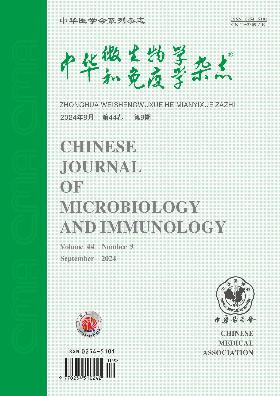粪便微生物群移植在大鼠内毒素性急性肺损伤中的作用及其机制
Q4 Immunology and Microbiology
引用次数: 0
摘要
目的观察粪便微生物群移植(FMT)对脂多糖(LPS)诱导的大鼠急性肺损伤(ALI)的影响,探讨其可能的机制,为治疗急性肺损伤提供新的思路。方法健康雄性SPF级SD大鼠45只,随机分为生理盐水组、LPS组和FMT组,每组15只。大鼠腹腔注射LPS 5mg/kg,诱发ALI。FMT组在ALI诱导后给予10ml/kg粪便微生物群溶液干预(每天两次,连续两天)。每组随机选择5只大鼠,分别于干预后24小时、48小时和72小时处死。苏木精和伊红(HE)染色检查肺组织的病理变化,并评估病理评分。对右肺样本进行称重以测量湿/干(W/D)比。采集腹主动脉血样进行PaO2分析。采用酶联免疫吸附法(ELISA)检测支气管肺泡灌洗液(BALF)中肿瘤坏死因子-α(TNF-α)、白细胞介素-1β(IL-1β)、白介素-6(IL-6)的水平。采用逆转录聚合酶链式反应(RT-PCR)分析转化生长因子-β(TGF-β)和细胞内信号转导蛋白Smads(Smad3和Smad7)在mRNA水平上的表达。蛋白质印迹法检测ERK1/2和p-ERK1/2在蛋白质水平上的表达。收集大鼠粪便样本以提取DNA,并通过Illumina MiSeq对V3和V4区域的PCR产物进行测序。基于操作分类单元(OTU)聚类,使用Illumina MiSeq对微生物群进行生物信息学分析。结果与NS组相比,LPS组肺泡间隔明显变宽,肺组织炎性细胞大量浸润,部分肺泡塌陷。与LPS组相比,FMT组明显减轻了炎症细胞浸润,减轻了肺间质组织的肿胀,对肺结构的损伤较小。与NS组相比,LPS组的W/D肺比值、PaO2浓度以及BALF中TNF-α、IL-1和IL-6水平在干预后24小时显著升高,然后逐渐降低,但仍高于NS组(P<0.05),FMT组BALF中IL-1和IL-6水平显著低于LPS组(P<0.05),TGF-β1和Smad3在mRNA水平的表达显著低于LPS组(P<0.05),而Smad7在mRNA水平上的表达较高(P<0.05),p-ERK在LPS组中的表达显著增加,在24 h时最高,在48 h和72 h时逐渐降低(p<0.05)。FMT组p-ERK的表达显著低于LPS组(p<0.01)。肠道微生物群测序结果显示,NS组为1362个OTU,LPS组为1443个OTU和FMT组为1510个OTU。共有336个OTU,占26.4%。LPS组肠道微生物群的组成与正常大鼠显著不同,其特征是随着厚壁菌门/拟杆菌门比例的增加和肠道微生物群基因丰度的降低,肠道微生物群具有高度多样性。粪菌移植干预后,FMT组肠道微生物群组成与NS组相似,表现为厚壁菌门/拟杆菌门比例降低,细菌群落基因丰度增加(P<0.05)。结论FMT可抑制免疫炎症,减少体内炎症标志物的产生和分泌,通过调节肠道微生物群和TGF-β1/Smads/ERK途径减轻肺泡上皮损伤和异常修复,改善LPS诱导的大鼠内毒素性ALI。关键词:急性肺损伤;粪便微生物群移植;高通量测序;脂多糖本文章由计算机程序翻译,如有差异,请以英文原文为准。
Involvement and mechanism of fecal microbiota transplantation on endotoxic acute lung injury in rats
Objective To observe the effects of fecal microbiota transplantation (FMT) on acute lung injury (ALI) induced by lipopolysaccharide (LPS) in rats and to investigate the possible mechanism in order to provide new thoughts for the treatment of acute lung injury. Methods Forty-five adult healthy male SPF level SD rats were randomly divided into three groups of normal saline (NS), LPS and FMT with 15 in each group. ALI was induced by intraperitoneal injection of rats with 5 mg/kg of LPS. The FMT group was given 10 ml/kg of fecal microbiota solution intervention (twice a day for two consecutive days) after ALI induction. Five rats in each group were randomly selected and sacrificed at 24 h, 48 h and 72 h after intervention. Pathological changes in lung tissues were examined with hematoxylin and eosin (HE) staining and pathological scores were assessed. Right lung samples were weighed to measure wet/dry (W/D) ratios. Abdominal aorta blood samples were collected for PaO2 analysis. The levels of tumor necrosis factor-α (TNF-α), interleukin-1β (IL-1β) and interleukin 6 (IL-6) in bronchoalveolar lavage fluid (BALF) were detected by enzyme linked immunosorbent assay (ELISA). Expression of transforming growth factor-β (TGF-β) and intracellular signal transduction protein Smads (Smad3 and Smad7) at mRNA level was analyzed by reverse transcription-polymerase chain reaction (RT-PCR). Expression of ERK1/2 and p-ERK1/2 at protein level was detected by Western blot (WB). Rat fecal samples were collected to extract DNA and the PCR products of V3 and V4 regions were sequenced by Illumina MiSeq. Bioinformatics analysis on microbiota was conducted with Illumina MiSeq based on operational taxonomic unit (OTU) clustering. Results Compared with the NS group, the LPS group showed significantly widened alveolar septa, massive inflammatory cell infiltration and some alveolar collapse in lung tissues. Compared with the LPS group, the FMT group showed significantly alleviated inflammatory cell infiltration, reduced swelling in pulmonary interstitial tissues, and less damage to pulmonary structure. Compared with the NS group, the W/D lung ratio, PaO2 concentration and TNF-α, IL-1 and IL-6 levels in BALF in the LPS group significantly increased at 24 h after intervention and then gradually decreased, but still higher than those in the NS group (P<0.05). The W/D lung ratio, PaO2 concentration and TNF-α, IL-1 and IL-6 levels in BALF of the FMT group were significantly lower than those of the LPS group (P<0.05). Compared with the NS group, the expression of TGF-β1 and Smad3 at mRNA level in lung tissues increased at all time points in the LPS group, while the expression of Smad7 at mRNA level decreased (P<0.05). The expression of TGF-β1 and Smad3 at mRNA level in the FMT group were significantly lower than that in the LPS group (P<0.05), while the expression of Smad7 at mRNA level was higher (P<0.05). Compared with the NS group, p-ERK expression significantly increased in the LPS group with the highest expression at 24 h and gradually decreased at 48 h and 72 h (P<0.05). The expression of p-ERK in the FMT group was significantly lower than that in the LPS group (P<0.05). Results of the intestinal microbiota sequencing revealed 1 362 OTU in the NS group, 1 443 OTU in the LPS group and 1 510 OTU in the FMT group. There were 336 OTU shared by them accounting for 26.4%. The constitution of intestinal microbiota in the LPS group was significantly different with that of normal rats and characterized by high diversity with increased Firmicutes/Bacteroidetes ratio and decreased gene abundance of intestinal microbiota. After the intervention of fecal bacteria transplantation, the constitution of intestinal microbiota in the FMT group was similar to that of the NS group, showing decreased Firmicutes/Bacteroidetes ratio and increased gene abundance of the bacterial community (P<0.05). Conclusions FMT might inhibit immune inflammation, reduce the production and secretion of inflammatory markers in the body, alleviate alveolar epithelial damage and abnormal repair through regulating intestinal microbiota and TGF-β1/Smads/ERK pathway to improve the LPS-induced endotoxic ALI in rats. Key words: Acute lung injury; Fecal microbiota transplantation; High-throughput Sequencing; Lipopolysaccharide
求助全文
通过发布文献求助,成功后即可免费获取论文全文。
去求助
来源期刊

中华微生物学和免疫学杂志
Immunology and Microbiology-Virology
CiteScore
0.50
自引率
0.00%
发文量
6906
期刊介绍:
Chinese Journal of Microbiology and Immunology established in 1981. It is one of the series of journal sponsored by Chinese Medical Association. The aim of this journal is to spread and exchange the scientific achievements and practical experience in order to promote the development of medical microbiology and immunology. Its main contents comprise academic thesis, brief reports, reviews, summaries, news of meetings, book reviews and trends of home and abroad in this field. The distinguishing feature of the journal is to give the priority to the reports on the research of basic theory, and take account of the reports on clinical and practical skills.
 求助内容:
求助内容: 应助结果提醒方式:
应助结果提醒方式:


